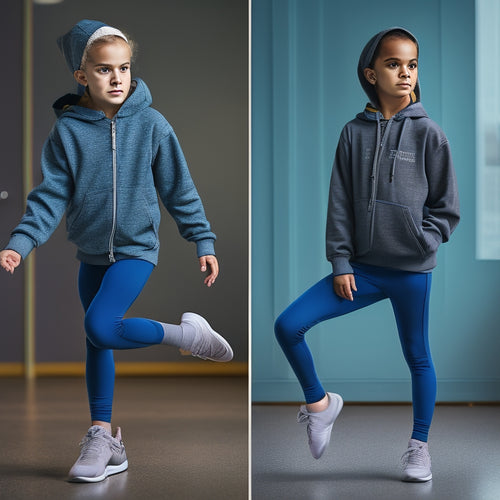
7 Best Hip Flexibility Exercises for Dancer's Freedom
Share
You're about to enhance a full range of motion in your hips, freeing you to dance with unbridled expression and precision. The 7 best hip flexibility exercises tailored specifically for dancers like you include Lateral Leg Lifts for width, Pigeon Pose for external rotation, Sumo Squats for deep hips, Lying Leg Circles for flexion, Knee to Chest Stretch for release, Side Lunges for abduction, and Wall Sits for endurance. These exercises will improve your hip stability, balance, and overall dance performance. By mastering these exercises, you'll be dancing with unprecedented freedom and flair - and that's just the beginning of your journey to peak hip flexibility.
Key Takeaways
• Lateral Leg Lifts target the gluteus medius muscle, improving hip stability and balance, and can be performed in 3 sets of 10-12 reps on each leg.
• Pigeon Pose enhances external hip rotation, targeting the gluteus medius and minimus, and should be held for 3-5 breaths for maximum relaxation.
• Sumo Squats widen the stance to target the adductor magnus muscle, improving hip mobility, and require a neutral spine and engaged core.
• Lying Leg Circles target the iliopsoas muscle for hip flexion, increasing range of motion and reducing stiffness, and should be performed with both straight and bent legs.
• Regular practice of these exercises, including Wall Sits, can improve overall dance performance by enhancing hip flexibility and strength.
Lateral Leg Lifts for Width
Regularly incorporating lateral leg lifts into your routine can greatly enhance your overall hip flexibility and width, allowing you to move with greater ease and fluidity. This exercise is a game-changer for dancers, as it targets the gluteus medius muscle, which is responsible for hip abduction. By strengthening this muscle, you'll improve your overall hip stability and balance.
To perform lateral leg lifts correctly, engage your core and maintain a neutral spine. Lift your leg out to the side, keeping it straight, and hold for a brief moment before slowly lowering it back down. Aim for 3 sets of 10-12 reps on each leg. It's essential to maintain proper form to avoid muscle imbalance, which can lead to injuries.
Focus on slow and controlled movements, and don't sacrifice form for quantity. As you incorporate lateral leg lifts into your routine, you'll notice improved flexibility, balance, and overall dance performance. With consistent practice and proper technique, you'll be dancing with greater freedom and confidence in no time!
Pigeon Pose for External Rotation
By incorporating pigeon pose into your routine, you'll greatly enhance your external hip rotation, allowing for a deeper range of motion and increased flexibility in your hips. This foundational yoga pose targets the external rotators of the hip, specifically the gluteus medius and minimus, which are essential for stability and balance.
As you move into pigeon pose, engage your core and maintain a neutral spine to guarantee a safe and effective stretch.
As you sink deeper into the pose, focus on activating your glutes to maintain proper alignment and prevent strain on your joints. You'll feel a gentle stretch in the front of your hip, indicating that your external rotators are lengthening.
Hold the pose for 3-5 breaths, breathing deeply and slowly to allow for maximum relaxation of the muscles.
Sumo Squats for Deep Hips
In sumo squats, you'll widen your stance to drop deeper into your hips, effectively targeting the adductor magnus muscle, which is responsible for hip abduction and external rotation. This exercise is a game-changer for hip mobility, allowing you to access deeper ranges of motion and access a more fluid, dynamic movement.
As you lower into the squat, focus on maintaining a neutral spine and engaging your core to support your pelvis. Allow your hips to drop, keeping your weight evenly distributed between both legs.
As you descend, focus on a subtle pelvic tilt, allowing your hips to release downward. This subtle adjustment will help you tap into the deeper ranges of your hip joint, increasing your overall hip mobility.
Remember to breathe naturally and avoid bouncing or forcing your way into the squat. Instead, focus on slow, controlled movements, pausing briefly at the bottom of the squat to savor the stretch. With consistent practice, you'll find your hip flexion increasing, and your overall movement becoming more fluid and expressive.
Lying Leg Circles for Flexion
You'll target the iliopsoas muscle, a key player in hip flexion, by performing lying leg circles, which will help increase your range of motion and reduce stiffness in the front of your hip. This exercise is a game-changer for dancers, as it allows for controlled, isolated movement that strengthens and stretches the hip flexors.
To perform lying leg circles, start by lying on your back with your legs straight and engage your core to maintain a stable pelvis. Lift one leg about 6-8 inches off the ground, keeping it straight, and draw small circles with your toes. Focus on muscle isolation, ensuring that only your leg is moving while your core remains stable.
Here's a breakdown of the exercise:
| Leg Position | Circle Direction | Repetitions |
|---|---|---|
| Straight up | Clockwise | 5-8 |
| Straight up | Counterclockwise | 5-8 |
| Bent at 90° | Clockwise | 5-8 |
| Bent at 90° | Counterclockwise | 5-8 |
Remember to switch legs and repeat on the other side. By incorporating lying leg circles into your routine, you'll experience improved hip flexibility, reduced stiffness, and enhanced overall dance performance.
Knee to Chest Stretch for Release
As you've increased your hip flexion with lying leg circles, now it's time to release tension in the hip flexors with the knee to chest stretch, which will help lengthen the iliopsoas muscle and promote further flexibility gains.
This stretch is crucial for dancers, as it allows for a deeper range of motion and reduces the risk of injury.
To perform the knee to chest stretch, start by lying on your back with your knees bent and feet flat on the floor. Engage your core and maintain a slight pelvic tilt to guarantee a neutral spine. Slowly bring one knee towards your chest, keeping your foot flexed, and hold for 20-30 seconds. Return to the starting position and repeat on the other side.
Remember to breathe naturally and avoid bouncing or forcing the stretch.
As you hold the stretch, focus on releasing tension in your hip flexors and maintaining a strong, engaged core. This will help you maintain control and stability throughout the movement.
With consistent practice, you'll notice increased flexibility and a greater range of motion in your hips, allowing you to move with more freedom and confidence.
Side Lunges for Abduction
As you prepare to execute side lunges for abduction, remember that maintaining proper alignment is vital - you must keep your shoulders down and away from your ears, with your spine long and engaged.
You'll also want to focus on controlling your lunge depth, ensuring that you're not pushing past a comfortable range of motion.
Proper Alignment
Engage your core and maintain a tall posture as you prepare to execute side lunges, an essential exercise for enhancing abduction and ultimately, hip flexibility. As you stand with your feet hip-width apart, make sure your weight is evenly distributed between both legs.
Take a large step to one side, keeping your back straight and your shoulders relaxed. It's important to maintain proper alignment to target the correct muscles and avoid injury.
Keep your front knee in line with your toes, and avoid letting it extend past your toes. Your back leg should be straight, with your heel grounded. Engage your core to support your lower back and maintain posture awareness. This will help you maintain balance and stability throughout the exercise.
As you lower into the lunge, keep your movements slow and controlled. Avoid bouncing or jerking, which can put unnecessary stress on your joints. By focusing on proper alignment and core engagement, you'll be able to execute side lunges with confidence and precision, ultimately enhancing your hip flexibility and overall dance performance.
Lunge Depth Control
You'll achieve ideal lunge depth control by focusing on a 90-degree bend in your front knee, which allows for a deeper stretch in your hip abductor muscles. This control is important for targeting the gluteus medius, a key muscle in hip abduction. To master lunge depth control, make sure you're engaging your core and maintaining proper body positioning.
Here's a checklist to make sure you're on the right track:
| Lunge Depth Control Checkpoints | Yes/No |
|---|---|
| Front knee bent at 90-degree angle | |
| Back knee almost touching the ground | |
| Core engaged for stability | |
| Body positioned upright, not leaning | |
| Weight evenly distributed between legs |
Wall Sits for Endurance
Can you maintain a steady, 90-degree angle for an extended period, even when fatigue sets in, to truly maximize the benefits of wall sits for enhanced endurance? This is the key to unleashing the full potential of wall sits for dancers.
As you descend into the wall sit, engage your core and maintain a straight back, keeping your knees bent at a 90-degree angle. Hold for 30 seconds to start, and gradually increase your time as you build endurance.
As you hold the position, focus on maintaining proper form, even when muscle fatigue sets in. This is where the real advantages of wall sits come into play - building endurance and strengthening your muscles to support your dance movements.
Don't sacrifice form for the sake of holding on longer; instead, listen to your body and take breaks when needed. Remember, the goal is to build strength and endurance, not to push yourself to injury.
With consistent practice and patience, you'll be amazed at the progress you'll make in your dance technique and overall flexibility.
Frequently Asked Questions
How Often Should I Practice Hip Flexibility Exercises for Optimal Results?
To achieve best results, you should practice hip flexibility exercises consistently, ideally 3-4 times a week, incorporating them into your daily routine, as consistency matters in reaching your flexibility goals.
Can I Modify These Exercises for Dancers With Knee or Hip Injuries?
When dealing with knee or hip injuries, you'll want to make gentle adaptations to your exercises, incorporating injury modifications that prioritize safety and comfort, ensuring a pain-free, empowering practice that honors your body's limitations.
How Long Does It Take to See Improvements in Hip Flexibility?
You'll start noticing improvements in hip flexibility within 4-6 weeks of consistent practice, but be patient, as genetic limitations and flexibility plateaus can slow progress - stay committed and celebrate small victories along the way!
Are There Specific Exercises for Improving Hip Flexibility in Ballet Dancers?
You'll be delighted to know that specific exercises tailored for ballet dancers do exist! Focus on Pirouette preparation and Turnout techniques to improve hip flexibility, ensuring a stronger, safer dance practice that lets you shine on stage!
Can I Combine Hip Flexibility Exercises With Strength Training Workouts?
You can definitely combine hip flexibility exercises with strength training workouts, leveraging cross-training benefits. Integrate Pilates to enhance core strength, balance, and flexibility, ensuring a safe and effective dance practice.
Related Posts
-

Learn Dance Makeup Artistry Online: A Step-by-Step Guide
You're about to begin an exciting journey to master the art of dance makeup online! First, you'll need to select the ...
-

What Makes a Stunning Lyrical Dance Makeup Look?
You craft a stunning lyrical dance makeup look by balancing ethereal, emotive essence with subtle, shimmering accents...
-

Dance Moms' Must-Have: Stylish College Hoodie
As a dance mom, embracing a lifestyle of comfort and style is essential, and that's where the must-have stylish colle...


